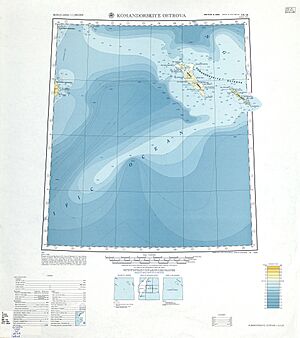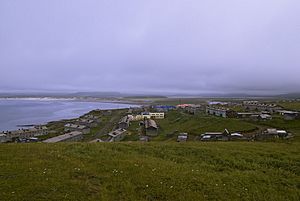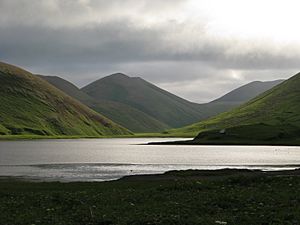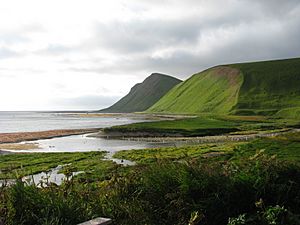Commander Islands facts for kids
Quick facts for kids
Commander Islands
|
|
|---|---|
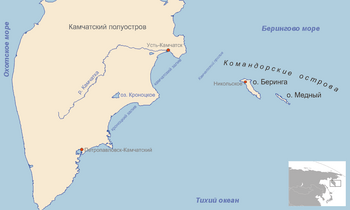
Map showing the position of the Commander Islands to the east of Kamchatka. The larger island to the west is Bering Island; the smaller island is Medny.
|
|
| Settlement | Nikolskoye 55°12′N 165°59′E / 55.200°N 165.983°E |
| Ethnic groups | |
| Area | |
|
• Total
|
1,846 km2 (713 sq mi) |
| Population | |
|
• 2009 estimate
|
613 |
The Commander Islands are a small group of islands in the Bering Sea. They are also known as the Komandorski Islands. These islands are found about 175 kilometers (109 miles) east of the Kamchatka Peninsula in the Russian Far East. The islands have very few trees and not many people live there.
The Commander Islands include two main islands: Bering Island and Medny Island. Bering Island is about 95 km (59 miles) long and 15 km (9 miles) wide. Medny Island is smaller, about 55 km (34 miles) long and 5 km (3 miles) wide. There are also fifteen smaller islands and rocks. The largest of these are Tufted Puffin Rock (also called Kamen Toporkov) and Kamen Ariy. These smaller islands are located a few kilometers west of Nikolskoye, the only village. The Commander Islands are part of the Kamchatka Krai region in Russia.
Contents
Exploring the Geography of the Commander Islands
The Commander Islands are the most western part of the Aleutian Islands. Most of the other Aleutian Islands belong to the US state of Alaska. The Commander Islands are separated from the closest US island, Attu Island, by about 207 miles (333 km). The International Date Line runs between them.
The islands have different types of land. You can find folded mountains, flat areas formed by volcanoes, and low mountains. These islands were formed by ancient volcanoes. They sit on the edge of the Pacific Plate and North American Plate. The highest point is Steller Peak on Bering Island, which is 755 meters (2,477 feet) tall. On Medny Island, the highest point is Stenjeger's Peak, at 647 meters (2,123 feet).
The weather on the Commander Islands is usually mild and wet. It rains often, about 220 to 240 days a year. Summers are cool and often very foggy.
Life and People on the Commander Islands
The only place where people live all the time is the village of Nikolskoye. It is located on the northwest side of Bering Island. In 2009, about 613 people lived there. Most of the people are Russians and Aleuts.
A large part of the islands and the nearby ocean is a protected nature area called the Komandorsky Zapovednik. This means it's a strictly protected wilderness. The main ways people make a living here are by fishing, gathering mushrooms, working for the nature preserve, and helping with ecotourism. There are also government jobs.
The village of Nikolskoye has a school, a satellite tracking station, and a dirt airstrip.
There are a few other small settlements on the islands, but they are mostly abandoned or have very few houses. These include:
- Severnoye
- Podutesnaya
- Gladkovskeya
- Lisennova
- Peschanka
- Preobrajenskoe Settlement at Peschanaya Bay on Medniy Island – abandoned
- Glinka
Amazing Animals and Plants
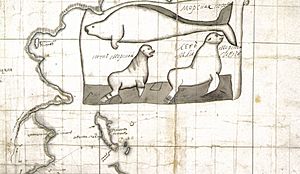
The Commander Islands do not have real forests. Instead, you'll find lots of lichens and mosses. There are also many marshy plants with short grass and small, dwarf trees. Very tall plants from the carrot family (called umbellifers) are also common.
Marine Mammals of the Commander Islands
The waters around the Commander Islands are full of marine animals. This is because the Bering Sea and Pacific Ocean provide a lot of food. Also, the islands are far from major human activity.
Huge numbers of northern fur seals (around 200,000) and Steller sea lions (about 5,000) come here in the summer. They use the islands for having their babies and for resting. Sea otters, common seals, and larga seals are also found in large numbers. The sea otter population here is actually growing, which is great news, as their numbers are falling in other parts of the Aleutian Islands.
Many types of whales visit these waters to feed, spend the winter, or migrate. Some of these whales are endangered. You might see sperm whales, orcas, different kinds of Minke whales, beaked whales, and porpoises. Humpback whales and endangered species like the North Pacific right whales and fin whales also swim here.
Bering Island was once home to the Steller's sea cow. This was a huge animal, weighing over 4,000 kg (8,800 pounds), similar to a manatee. Sadly, it was hunted to extinction within 27 years of being discovered in 1741.
Land Animals and Birds
There are fewer land animals on the islands. Two special types of Arctic fox live here. In the past, their numbers dropped a lot because of the fur trade. Most other land animals, like wild reindeer, American mink, and rats, were brought to the islands by humans.
Over a million seabirds come to nest on the cliffs along the coast. Common birds include northern fulmars, different types of murres and guillemots, horned and tufted puffins, cormorants, gulls, and kittiwakes. The rare red-legged kittiwake nests here, which is special because it nests in only a few other places in the world.
Waterfowl and sandpipers are also common in the valleys of Bering Island. Important migratory birds that nest or feed here include Steller's eider, Pacific golden plover, and Aleutian tern. You might also spot rare birds of prey like the Steller's sea eagle and gyrfalcon. In total, over 180 different bird species have been seen on the Commander Islands.
Another bird, the spectacled cormorant, which was a large bird that could barely fly, became extinct around 1850. The islands are recognized as an Important Bird Area (IBA) by BirdLife International. This means they are very important for many threatened bird species, especially waterbirds and seabirds.
The fast-flowing streams in the mountains are home to many migratory salmon fish. These include Arctic char, Dolly Varden, black spotted trout, chinook, sockeye, coho, and pink salmon.
There are no amphibians or reptiles living on the Commander Islands.
A Look Back at History
The Commander Islands got their name from Commander Vitus Bering. His ship, the St Peter, crashed on Bering Island in 1741. This happened during his trip back from Alaska. Bering and many of his crew died on the island. His grave is marked by a simple monument.
About half of the crew survived the winter. They were helped by the many animals on the island, especially the newly discovered Steller's sea cow. A scientist and doctor named Georg Wilhelm Steller also helped by making the men eat seaweed, which cured many of them of scurvy. Eventually, the survivors built a smaller boat from the remains of the St. Peter. They sailed back to Kamchatka, carrying valuable sea otter furs.
The discovery of these sea otters started a big rush for furs. This led to Russia expanding into Alaska. Sadly, the Steller's sea cow, which only lived around Bering Island, was completely hunted out by 1768.

In 1825, Aleut people were moved to the Commander Islands by the Russian-American Company. They came from the Aleutian Islands to help with the seal trade. Most of the Aleuts on Bering Island came from Atka Island. Those on Medny Island came from Attu Island. Today, these islands are part of the United States.
A special language called Mednyj Aleut developed among the people. It had Aleut words but used Russian ways of forming verbs. Today, about two-thirds of the island's population is Russian, and one-third is Aleut.
A famous naval battle, the Battle of the Komandorski Islands, happened in 1943. It took place in the open sea about 160 km (99 miles) south of the islands.
See also
 In Spanish: Islas del Comandante para niños
In Spanish: Islas del Comandante para niños


